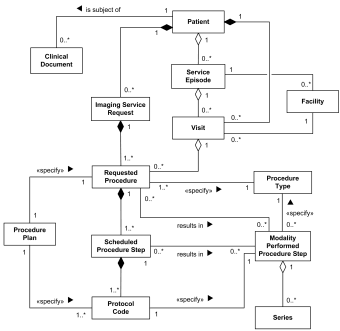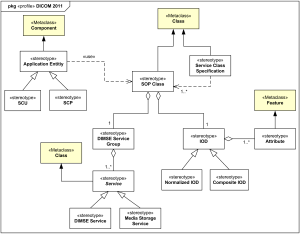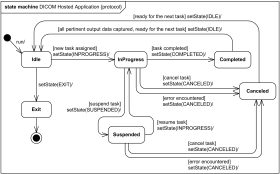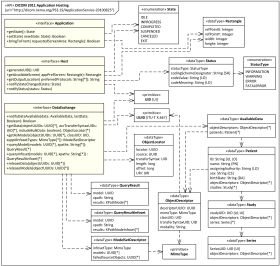Digital Imaging and Communications
in Medicine (DICOM)
UML Diagrams Examples
Here we provide some examples of UML diagrams related to the Digital Imaging and Communications in Medicine (DICOM) Standard.
The DICOM Standard published by the National Electrical Manufacturers Association (NEMA) facilitates interoperability of medical imaging equipment, promotes communication of digital image information, regardless of device manufacturer, alleviates the development and expansion of Picture Archiving and Communication Systems (PACS) that can also interface with other systems of hospital information, allows creation of diagnostic information databases that can be interrogated by a wide variety of devices distributed geographically.
The Part 19 of the DICOM Standard defines an application programming interface (API) between two software applications - Hosting System and Hosted Application, both applications exchanging medical data while located on the same system.
The Hosting System (Host) (aka Host Application) is an application used to launch and control hosted applications. The Hosting System provides a variety of services such as DICOM object retrieval and storage for the hosted application. Host application provides the hosted one with data, such as a set of medical images and related metadata.
The Hosted Application (Application) is an application launched and controlled by a hosting system, which may also utilize some services offered by the hosting system. Hosted application processes provided medical data, potentially returning back some newly generated data, for example in the form of another set of images and/or structured reports, to the hosting application.
Purpose: Represent domain model ("model of the real world") for Digital Imaging and Communications in Medicine (DICOM) - Patient, Visit, Facility, Imaging Service Request, Scheduled Procedure Step, Modality Performed Procedure Step.
Summary: UML diagram example represents DICOM extended domain, abstract description of the real world objects used in the Modality-IS Interface. Modality is a piece of medical imaging equipment, e.g. computed tomography (CT) or ultrasound (US).
Purpose: An example of UML profile diagram for Digital Imaging and Communications in Medicine (DICOM).
Summary: The DICOM standard facilitates interoperability of medical imaging equipment, promotes communication of digital image information, regardless of device manufacturer.
Purpose: An example of UML protocol state machine diagram for DICOM Application Hosting API. The Application Hosting API describes interfaces between two software applications - Hosting System and Hosted Application, exchanging medical data while located on the same system.
Summary: Hosting system initializes hosted application by issuing a run or exec command or its equivalent. Once the hosted application is initialized, for the normal workflow its state transitions through Idle, InProgress, and Completed states. In some cases application could be Suspended or even Canceled.
Purpose: An example of UML class diagram representing DICOM Application Hosting API, defined in Part 19 of DICOM Standard (PS 3.19-2011).
Summary: The DICOM Application Hosting API defines three interfaces - Application, Host, and DataExchange interface. Hosting System provides a variety of services such as DICOM object retrieval and storage to Hosted Application. The latter processes provided medical data, potentially returning back some newly generated data sets.



